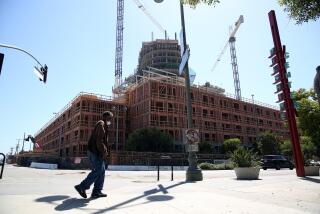Materials add up ... way up
A painting contractor by trade, Don Dellino knows a lot more about residential remodeling than your average homeowner. But even he was startled by the recent run-up in construction costs due in large part to soaring prices of building materials. Dellino and his wife are expanding their two-bedroom Manhattan Beach home into a 3,900-square-foot Italian-style villa.
“One bid for the roof was $14,000 higher if I decided to use copper flashing,” said Dellino, who opted for the less expensive -- if less attractive -- galvanized metal. Despite his cost-cutting, however, Dellino’s home makeover will wind up costing about $450,000, significantly higher than his own original estimate of $300,000.
The sharply rising cost of materials is creating a financial headache for homeowners planning everything from simple maintenance projects to full-scale renovations. Remodelers such as Dellino are opting, in part, for cheaper materials to contain costs. But most are digging deeper into their pockets and paying more. Homeowners are finding that some contractors are shortening the expiration dates on their bids or adding contractual clauses to protect themselves from price hikes in materials.
Since the spring of 2003, skyrocketing prices for construction supplies -- including cement, drywall, lumber and nails -- have swelled the cost of building a new house by about $7,000, according to Michael Carliner, an economist with the National Assn. of Home Builders, an industry trade group in Washington, D.C.
“The biggest component of that has been the increase in wood products,” Carliner said.
Of course, consumer prices in general increased last year. Food rose 2.7% and energy costs, including gasoline, escalated 17%, according to the Department of Labor’s consumer price index.
But construction materials have climbed even more steeply, according to NAHB statistics. Nationwide, lumber prices jumped about 27% in 2004, said the NAHB, while scrap steel -- used in nails, wire mesh and other building materials -- rose 80% and cement, 6%. For consumers, that translates into higher prices for nails, drywall and boards at checkout stands and higher bids from contractors.
In Los Angeles County, the price of plywood jumped 47.5% last year. Steel studs (sometimes used in place of framing lumber) shot up 37%, and lumber climbed 21%, according to Marshall & Swift, a research firm that provides the insurance industry with building cost data. Orange, Riverside, San Bernardino and Ventura counties experienced similar increases.
Prices have risen for numerous reasons. Rebuilding efforts in Florida, which suffered a series of destructive hurricanes last year, have siphoned away much of the available cement, a situation that may not improve until spring, the NAHB said.
Large-scale projects in China have tapped a large portion of the world’s steel, and political squabbles -- including a 3-year-old U.S.-Canada trade dispute over softwood lumber -- have added to price volatility.
Tsunami-related rebuilding in Asia is unlikely to affect North American materials prices this year, however, as builders in the devastated areas will likely use local or regional materials, according to the home builders’ trade group.
The good news: Prices may stabilize or drop early this year, particularly once Florida acquires all the materials it needs for post-hurricane rebuilding, the NAHB said.
Despite the higher prices, Southern California home remodelers and contractors report that business is brisk -- although adding that some homeowners are having second thoughts about proceeding with room additions, kitchen expansions and other projects upon learning that remodeling costs will far exceed their budgets.
“The phone is still ringing off the hook. People still need the work done,” said Karen Zieba, vice president of Zieba Builders Inc., a design-build firm in Long Beach. “But fewer people are actually having it done, because they can’t afford it.”
Homeowners hoping to add a room or remodel a kitchen often have expectations that are “way out of whack” with what things cost, Zieba added. “A homeowner may have a number -- $200,000 -- in his head. And then we and our competitors bid it, and it’s more like $350,000. They’re aghast.”
Higher materials prices are “putting a dent in the affordability of the projects out there,” said Norm Kramer, certified remodeler and owner of Oakwood Remodeling & Construction in Bonsall, Calif.
One of Kramer’s potential clients wanted to build a 640-square-foot guest house on her property, a project she had budgeted at $80,000, or $125 per square foot.
“That’s fine for a shell, but you’re not going to get much beyond that,” said Kramer, who estimates the median price for a remodel/expansion at $200 to $225 per square foot.
One way to manage cost overruns is to plan for them. The National Assn. of the Remodeling Industry, a trade group in Des Plaines, Ill., recommends that once homeowners have determined a remodeling budget they set aside 10% to 20% of the total and place those funds in a reserve account to cover added expenses.
Despite the cost of materials, home improvement remained popular last year, as rising housing prices, increased homeowner equity and low interest rates gave consumers the financial means to upgrade. Americans spent $224 billion on remodeling projects in 2004, up from $214 billion in 2003, according to the remodeling association.
And, similar to what consumers see at the gas pump, materials prices tend to fluctuate a lot.
“Pricing for lumber can change from week to week,” said Bob Leon, general contractor and owner of Pro Builders Express in La Mirada.
For homeowners, this has meant less time to mull over a contractor’s bid. To protect themselves against a sudden upsurge in materials costs, contractors are shortening the expiration dates on their bids. “We were at 30 days, and now we’re down to 15 days,” Kramer said.
Los Angeles general contractor Bill Simone’s deadline is even shorter. “When we put together a proposal for our potential clients, it’s good for seven days.”
Equally troubling for homeowners are contractual clauses that protect contractors from materials price hikes.
“You can put in the contract that, if costs go up, we can be reimbursed,” Kramer said. “People don’t like to see that, but it’s one of those things you try to protect yourself on.”
Of course, the average homeowner doesn’t track the price of ready-mix concrete and asphalt shingles.
“I know what I spent, but I don’t know if that steel girder I put to support the roof was three times more expensive than it would have been three years ago,” said Chris Reedy, a financial advisor in Corona del Mar who two years ago -- just about the time the rise in drywall, plywood and steel studs started -- gutted his 2,700-square-foot 1955 home to bring it up to 2003 standards. “I’m just surprised at how expensive things get when you start putting in granite countertops.”
Indeed, the time-worn axiom remains true.
“The thing about remodeling,” Simone said, “is that it always costs more than you expect, and takes longer than you anticipated.”
*
(BEGIN TEXT OF INFOBOX)
Sticker shock
The prices of many building supplies surged from 2003 to 2004 in Los Angeles County. For example:
*--* Percent increase Asphalt shingles 5.4% Drywall 12.6% Lumber 21.0% Plywood 47.5% Ready-mix concrete 8.2% Rebar* 37.0% Steel studs 37.0%
*--*
* Used to reinforce concrete.
Source: Marshall & Swift
Jeff Bertolucci can be reached at jbert@aol.com.
More to Read
Inside the business of entertainment
The Wide Shot brings you news, analysis and insights on everything from streaming wars to production — and what it all means for the future.
You may occasionally receive promotional content from the Los Angeles Times.










